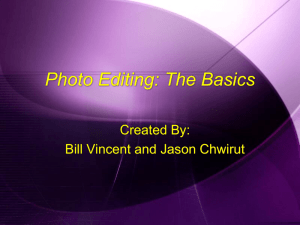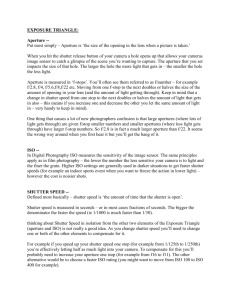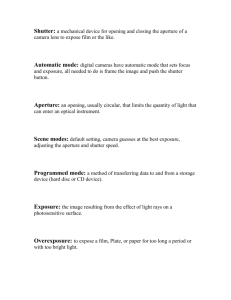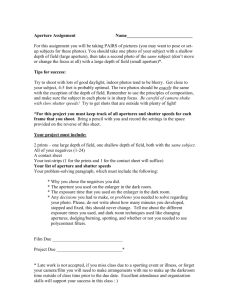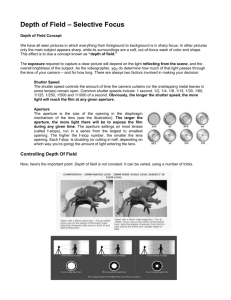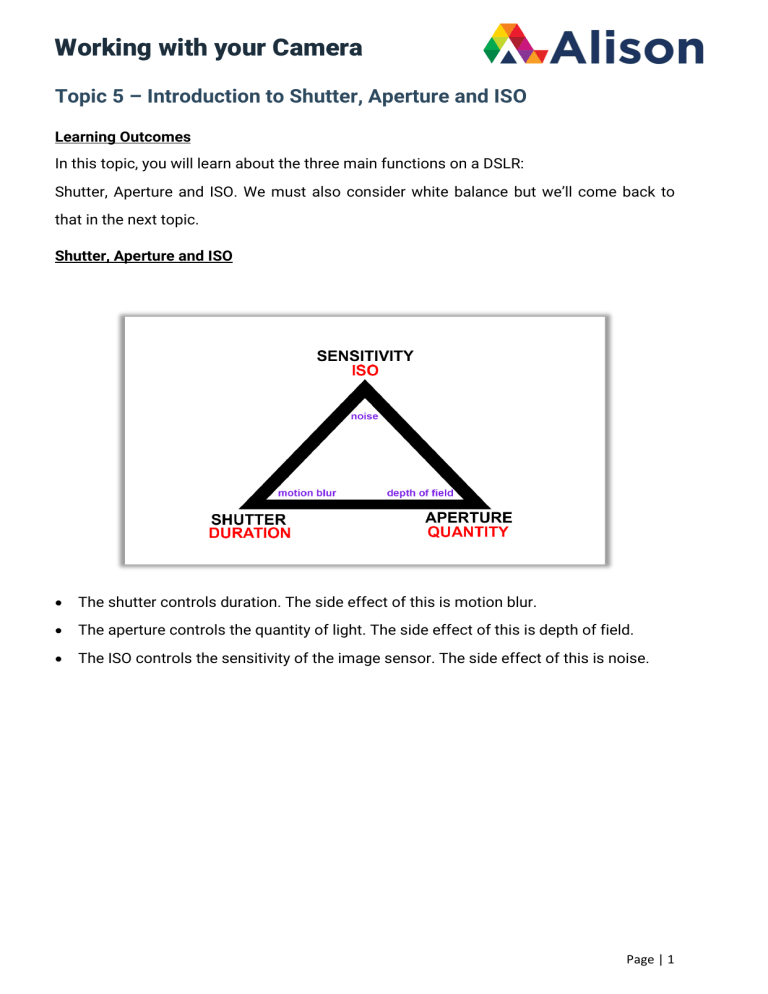
Working with your Camera Topic 5 – Introduction to Shutter, Aperture and ISO Learning Outcomes In this topic, you will learn about the three main functions on a DSLR: Shutter, Aperture and ISO. We must also consider white balance but we’ll come back to that in the next topic. Shutter, Aperture and ISO • The shutter controls duration. The side effect of this is motion blur. • The aperture controls the quantity of light. The side effect of this is depth of field. • The ISO controls the sensitivity of the image sensor. The side effect of this is noise. Page | 1 Working with your Camera Shutter Let’s start with the shutter. The simplest way to just focus on controlling the shutter only is by putting the camera into shutter priority mode on your mode dial. This is TV (Time Value) for Canon and S (Shutter) for Nikon. What happens when you do this? Well, as we have said before, you just take control of the shutter and your camera figures out your aperture and ISO automatically in order to create the correct brightness level in your image. This brightness level is known as exposure. In front of the image sensor, we have the shutter. Remember that this shutter is simply a curtain that opens and closes to expose the sensor to light so that you can capture your image. When you’re adjusting your settings in shutter priority mode, what you’re really adjusting is the duration that the curtain is open, exposing the sensor to light. The shutter settings control the exact duration for how long this shutter curtain is open. The side effect of shutter speed is motion blur. We need to think about what happens when that shutter is open and exposed to light. Unlike shooting a movie/ Page | 2 Working with your Camera film, where you’re capturing multiple frames per second and you’re getting that motion and playback, you’re just taking one frame so if you have motion while you’re taking that picture, you’re capturing it in the form of a blur. Not only are you thinking about the movement of your subject, you’re also thinking about the movement of your camera while you’re doing this. If this happens, you’re going to capture motion blur. Aperture The aperture is an iris that sits inside your lens and it opens and closes to control the quantity of light that enters your camera. Just to revise, remember that we also have the aperture priority setting. The simplest way to just focus on controlling the aperture only is by putting the camera into this aperture priority mode on your mode dial. With aperture, bigger numbers will mean that you will have a smaller opening of the iris as you can see from the diagram with f/ 16 having the smallest opening. If we lower the numbers, we can see that the iris gets bigger and allows light more light to come in. The side effect of aperture is depth of field. Quite simply, the depth of field is the area in focus in a photograph. This is what gets you that blurry background in your portrait shot vs one that gets more of the background in focus. By taking a photograph with a small aperture setting/ f stop number, meaning that your iris is open wide, you’re going to get a narrow area of focus. On the other hand, if you decrease the aperture setting/ f stop number, you widen the area that’s in focus, giving you a less blurred background effect. Page | 3 Working with your Camera Page | 4 Working with your Camera ISO The final mechanism that we can control is ISO. The ISO is simply a way to make the image sensor in our camera body more sensitive to light. Higher ISO numbers make the image sensor much more sensitive to light. The side effect of high ISO settings is noise. Noise is generally something that is not a creative choice but rather an undesired side effect that you have to deal with when shooting at high ISO settings. When you shoot in these high ISO settings you lose the quality in your image and you begin to see these artefacts and loss of detail in your photographs. So, why would you need to do this? Generally speaking, this occurs when you are shooting in low light conditions. You want to make your image sensor more sensitive to light, so you trade this off for shutter speed. This way, when you take a photograph, you’re not susceptible to motion blur at lower shutter speeds. You get yourself more shutter speed by making the image sensor more sensitive but you have to deal with noise in your images. Trade Off There is a distinct relationship between these three mechanisms. If you lean more towards one of the mechanism’s side effects, you have to take from the other two in order to maintain the same level of brightness, the same level of exposure. This is something that you must always keep in mind, especially in manual mode, because these three mechanisms are controlling how much light is being absorbed by the image sensor. • The shutter controls duration that light is allowed in. • The aperture controls the quantity of light. • The ISO controls the sensitivity of the image sensor. Page | 5 Working with your Camera Mastering these three mechanisms is the fundamental key to achieving balanced exposure in your photography. All of the other features on your camera are built around these three mechanisms so they are really important and if you understand what they are doing, you’ll be able to capture great photographs in any setting. Page | 6 Working with your Camera What have we learned today? A Summary • The shutter controls duration. The side effect of this is motion blur. • The aperture controls the quantity of light. The side effect of this is depth of field. • The ISO controls the sensitivity of the image sensor. The side effect of this is noise. • With aperture, bigger numbers will mean that you will have a smaller opening of the iris while smaller numbers will mean that you have a wider opening of the iris. • Finally, we’ve learned that there is a relationship between these three mechanisms and that when you lean more towards one, you change the other to compensate for exposure. Page | 7
